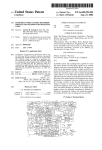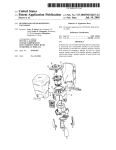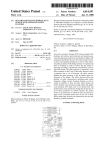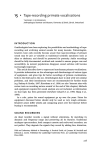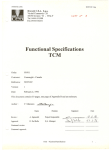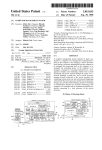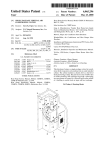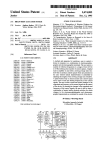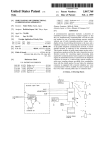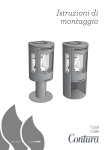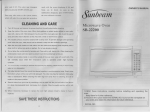Download Procedure alarm silence feature for medical telemetry system
Transcript
US006510344B1
(12) United States Patent
(10) Patent N0.:
(45) Date of Patent:
Halpern
FOR MEDICAL TELEMETRY SYSTEM
Selected pages, including p.2—2 describing “Alarm Silence
(75) Inventor: Arieh S. Halpern, Beverly Hills, CA
Key,” from Service Manual for Ohmeda Biox 3740 Pulse
(Us)
Oximeter, 3 pages, (1988).
(73) Assignee: GE Medical Systems Information
Technologies, Inc., Milwaukee, WI
Notice:
Jan. 21, 2003
Product literature describing controls and indicators of Phys
io—Control VSM 4 Vital Signs Monitor, 2 pages, (1986).
(54) PROCEDURE ALARM SILENCE FEATURE
(*)
US 6,510,344 B1
Operating Instructions for Datascope Passport 5L, Rev. E,
(Us)
dated Nov. 1, 1996 (see pp. 2—2 and 2—3).
Subject to any disclaimer, the term of this
patent is extended or adjusted under 35
Rev. 2, dated Jul. 26, 1991.
Operating Instructions for Datascope Visa Central Station,
U.S.C. 154(b) by 0 days.
* cited by examiner
(21) Appl. No.: 09/533,317
(22) Filed:
Primary Examiner—Jeffrey R. JastrZab
Mar. 22, 2000
Assistant Examiner—Frances P. OropeZa
(51)
Int. Cl.7 ................................................ .. A61N 1/18
(74) Attorney, Agent, or Firm—Foley & Lardner; Carl B.
(52)
US. Cl. ....................................................... .. 607/32
Horton
(58)
Field of Search ............................ .. 128/903; 607/4,
(57)
607/5, 9, 30, 32, 60; 600/301, 509, 300,
500, 503, 483; 340/517, 573.1, 825.06,
ABSTRACT
A medical telemetry system includes a procedure alarm
286.07
silence feature that enables a clinician to remotely disable a
(56)
monitoring station alarm in order to perform a patient
procedure that might cause inadvertent false alarms. To
disable the alarm for a preprogrammed time interval, the
clinician presses keys on the telemetry unit according to a
References Cited
U.S. PATENT DOCUMENTS
5,319,355 A
5,319,363 A
5,634,468 A
*
*
*
6/1994 Russek ..................... .. 340/573
6/1994 Welch et a1. ............. .. 340/825
6/1997 Platt et a1. ................ .. 128/696
5,822,435 A
5,919,141 A
6,028,514 A
* 10/1998 Boebert et a1.
* 7/1999 Money et a1.
* 2/2000 Lemelson et a1.
6,057,758 A
*
prede?ned key sequence that is selected so as to reduce a
likelihood of accidental alarm disablement. The monitoring
system responds to the prede?ned sequence by disabling an
audible alarm for all alarm conditions except class 1 arrhyth
mias. A corresponding visual alarm at the monitoring station
is maintained active. While the alarm is disabled, the moni
toring station displays an indication of the amount of time
until expiration of the preprogrammed time interval.
380/49
600/513
340/539
5/2000 Dempsey et a1. ......... .. 340/539
OTHER PUBLICATIONS
Selected Sections, including 5.3 (“Silencing Alarms”), from
Operating Instructions for Siemens Sirecust 720/722/730/
33 Claims, 1 Drawing Sheet
732 monitors, 4 pages, dated Mar. 1991.
Central Station 32
Lew
in“
42 ‘:0 Unlocked
34'
38
Call
‘36
40A:
PAS
]’—40
l
Receive PAS message
Display PAS message
Disable audible
alarm lor all but
class 1 arrhythmia
7
v
Send PAS
message to
central sta?on
Display/Update
time remaining
in PAS interval
PAS interval
emired or reset message
received ?
Send PAS
reset message
Clear PAS indlcators
to central station
enable audible alanns
irom display and
interval
emired
7
Y
Tum oif LED
and lock PAS
U.S. Patent
Jan. 21,2003
Telemeter Unit 30
FIG. 1
US 6,510,344 B1
Central Station 32
(FM
42 "0 Unlocked
33\ @/~36
(U
40”{\lFEl F40
=
.
PAS unlocked
i
( Receive PAS message >
i
Display PAS message
i
Disable audible
Unlock
period
expired
class 1 arrhythmia
Display/Update
?
Y
Send PAS
message to
central station
alarm for all but
time remaining
in PAS interval
PAS interval
expired or reset message
received ?
ressgnrgelléjge
Clear PAS indicators
_
from display and
to Central Statlon
enable audible alarms
(E
Turn off LED
and lock PAS
@
US 6,510,344 B1
1
2
PROCEDURE ALARM SILENCE FEATURE
FOR MEDICAL TELEMETRY SYSTEM
(preferably positioned on opposite sides of the telemeter
unit). The functions performed by these keys are summa
BACKGROUND OF THE INVENTION
Unlocked” LED 42 Which ?ashes indicating that the PAS
key is unlocked and can be actuated by pressing the PAS
key. The keys illustrated in FIG. 1 are for illustrative
purposes only, and are not intended to imply actual key siZes
riZed in Table 1. The telemeter unit 30 also includes a “PAS
Avariety of medical telemetry systems exist Which allow
the ECG Waveforms of hospital patients to be monitored in
real time. The ECG signals of the patient are sensed by a
or locations.
telemeter unit and a set of ECG leads, and are transmitted by
The default state of the PAS key 38 is “locked” (non
functional). To unlock the PAS key, the clinician holds doWn
both Attendant Present/Procedure Alarm Silence Unlock
keys 40 until the “PAS unlocked” LED 42 begins ?ashing.
As depicted by the telemeter ?oW diagram in FIG. 1, if the
PAS key is not thereafter pressed Within a preprogrammed
“unlocked” period, the LED stops ?ashing and the PAS key
the telemeter unit to a monitoring station (typically located
in a central location). In ambulatory systems, the telemeter
units are battery-poWered Wireless units that are Worn by the
patients. The telemeter units may also be designed to sense
and transmit other types of physiologic data such as pulse
oximetry, non-invasive and invasive blood pressure, end
15
The monitoring station, Which typically includes a PC or
is returned to the locked state. If, on the other hand, the PAS
key is pressed While unlocked, a PAS message is sent to the
other computer system coupled to a receiver, displays the
ECG Waveforms of multiple patients for vieWing by a
human operator. The monitoring station also applies
etc.) for the particular telemeter unit 30 and patient. The
tidal carbon dioxide, respiration, and temperature.
central station 32 (monitoring system), causing the central
station to enter into the PAS mode (audible alarms disabled,
central station remains in the PAS mode With respect to that
softWare-implemented analysis algorithms to check for
abnormalities, such as arrhythmia conditions, high and loW
alarm limits, and lost signals caused by loose leads. When
such an abnormality is detected, an alarm indicator is
displayed on the screen, and/or an audible alarm is sounded.
patient until expiration of a preprogrammed PAS interval,
such as tWo minutes, or until the PAS key is re-pressed,
Whichever occurs ?rst.
25
SUMMARY OF THE INVENTION
One problem With existing medical telemetry systems is
that false alarms frequently occur as the result of short-term
TABLE 1
Key Type
Description
Remote Record
A dedicated function key that initiates
a strip chart recording at the central
Nurse Call
A dedicated function key that initiates
procedures performed on the patients by nurses and other
(monitoring) station When depressed
clinicians. For example, a false alarm may occur When a
a nurse call at the central station
clinician replaces or repositions the ECG leads for patient.
As a result, clinicians are unnecessarily dispatched to
When depressed
Procedure Alarm Silence (PAS)
patients’ rooms or otherWise distracted.
The present invention overcomes this problem by provid
35
ing a “procedure alarm silence” feature through Which a
false alarms (changing lead Wires,
electrodes, etc.), and to disable
audible (but not visual) alarms
during the procedure. The PAS key
clinician can remotely disable the alarm from the bedside or
other patient location for a predetermined time. The feature
is preferably invoked by the clinician through a prede?ned
performs no function unless
unlocked.
sequence of key depressions or other actions on the teleme
ter unit. Once invoked, the monitoring station temporarily
Attendant Present/PAS Unlock
inhibits some or all types of alarms. In a preferred
A multi-function key pair used for
indicating that an attendant is present
and for unlocking the PAS key.
embodiment, for example, the monitoring station disables
When both keys are pressed and held
in for a preprogrammed time period,
the audible alarm for a tWo minute interval for all monitored
abnormalities except class 1 arrhythmia conditions. A cor
Used to inform clinicians at the
central station area that the attending
clinician Will be performing a
procedure that may cause inadvertent
45
an “Attendant Present” indication
responding visual alarm is preferably kept active. The pre
de?ned key sequence is preferably selected such that
is displayed at the central station.
If the clinician continues to hold
in both keys, a “PAS Unlock”
patients and clinicians are unlikely to invoke the feature
indicator begins ?ashing to indicate
(disable audible alarms) by accident.
that the PAS key is unlocked.
BRIEF DESCRIPTION OF THE DRAWING
FIG. 1 illustrates the operation of an example telemeter
unit and monitoring station according to the present inven
tion.
DETAILED DESCRIPTION OF A PREFERRED
EMBODIMENT
An example implementation of the invention Will noW be
described With reference to FIG. 1, Which is intended to
illustrate but not limit the invention. The scope of the
invention is de?ned by the appended claims.
As depicted in FIG. 1, the ambulatory telemeter units 30
(one shoWn) of the system include four types of buttons or
keys: a Remote Record key 34, a Nurse Call key 36, a
Procedure Alarm Silence (PAS) key 38, and a pair of
Attendant Present/Procedure Alarm Silence Unlock keys 40
As illustrated by the central station ?oW diagram, upon
receiving the PAS message and entering into the PAS mode,
55
the central station 32 disables the audible alarm for all but
class 1 arrhythmia alarm conditions. The visual alarms
preferably remain active. While in the PAS mode, a message
such as “Temporary Procedure Alarm Silence Activated,”
and a visual indication of the amount of time remaining in
the PAS interval, are displayed on a central station display
screen 32A in association With the particular patient’s data.
Once either a “PAS Reset” message is received from the
telemeter unit 30 (indicating a “PAS re-press” event) or the
PAS interval expires, the PAS message and “time remain
ing” indicator are cleared from the display and the audible
65 alarms are re-enabled.
As Will be apparent from the foregoing, any of a variety
of alternative key types and key depression sequences could
US 6,510,344 B1
4
3
a monitoring system that receives and displays the physi
ologic data transmitted by the ambulatory telemeter
unit, and analyses the physiologic data to check for at
be used to remotely disable the alarms. In addition, other
types of clinician actions could be used to initiate the PAS
mode, such as applying a magnetic or electronic key to the
telemeter unit. Further, although the feature is illustrated in
connection With a Wireless, ambulatory telemeter unit, the
feature may be incorporated into hardWired and other non
least one type of alarm condition;
Wherein the monitoring system is responsive to a pre
de?ned user action performed on the ambulatory tele
meter unit by preemptively disabling an alarm associ
ated With the ambulatory telemeter unit for a
ambulatory telemeter units.
What is claimed is:
1. In a system in Which physiologic data of a patient is
sensed and transmitted to a monitoring station by an ambu
latory telemeter unit Worn by the patient, and in Which the
monitoring station analyZes the physiologic data in real time
to check for alarm conditions, a method of remotely dis
abling an alarm of the monitoring station, comprising:
preprogrammed time interval, so that a clinician can
10
system responds to the prede?ned user action by disabling
15
detecting a prede?ned user action performed on the
the alarm for some, but not all, types of alarm conditions.
16. The system as in claim 15, Wherein the monitoring
system maintains the alarm in an active state during the
unit to the monitoring station to cause the monitoring
station to preemptively disable an alarm at the moni
preprogrammed time interval for class 1 arrhythmia alarm
conditions.
17. The system as in claim 13, Wherein the monitoring
toring station for a preprogrammed time period, to
thereby inhibit false alarms as a procedure is performed
system further responds to the prede?ned user action by
25
18. The system as in claim 13, Wherein the monitoring
system further responds to the prede?ned user action by
displaying an amount of time left until expiration of the
preprogrammed time interval.
3. The method as in claim 1, Wherein the prede?ned user
action comprises a sequence of key depressions in Which an
alarm silencing function is unlocked and then activated.
4. The method as in claim 1, Wherein the prede?ned user
action comprises applying an electronic or magnetic key to
19. The system as in claim 13, Wherein the prede?ned user
action comprises a prede?ned sequence of key depressions
on the ambulatory telemeter unit.
20. The system as in claim 19, Wherein the prede?ned
the ambulatory telemeter unit.
35
action comprises a prede?ned sequence of key depressions
on the ambulatory telemeter unit, the prede?ned sequence of
sequence of key depressions is selected so as to reduce a
likelihood that the alarm Will be disabled by accident.
21. The system as in claim 20, Wherein the prede?ned
sequence of key depressions requires at least tWo keys to be
held in a depressed state simultaneously.
22. The system as in claim 13, Wherein the prede?ned user
action comprises applying a key to the ambulatory telemeter
unit.
23. The system as in claim 13, Wherein the monitoring
key depressions selected so as to reduce a likelihood that the
alarm Will be disabled by accident.
6. The method as in claim 5, Wherein the prede?ned
sequence of key depressions requires at least tWo keys to be
held in a depressed state simultaneously.
7. The method as in claim 1, Wherein the message causes
the monitoring station to disable an audible alarm Without
disabling a corresponding visual alarm.
displaying an indication that the alarm associated With the
ambulatory telemeter unit is currently disabled.
be disabled by the patient.
5. The method as in claim 1, Wherein the prede?ned user
an audible alarm Without disabling a corresponding visual
alarm.
15. The system as in claim 13, Wherein the monitoring
system responds to the prede?ned user action by disabling
ambulatory telemeter unit Worn by the patient; and
responding to detection of the prede?ned user action by
transmitting a message from the ambulatory telemeter
on the patient.
2. The method as in claim 1, Wherein the prede?ned user
action is selected to reduce a likelihood that the alarm Will
remotely disable the alarm While performing a proce
dure on the patient.
14. The system as in claim 13, Wherein the monitoring
system is responsive to a second type of user action per
45
8. The method as in claim 1, Wherein the message causes
the monitoring station to disable the alarm for some, but not
formed With respect to the ambulatory telemeter unit by
enabling the alarm prior to eXpiration of the preprogrammed
time interval.
all, types of alarm conditions.
station responds to the message by maintaining the alarm in
24. A telemeter unit, comprising:
a housing having a plurality of keys;
an active state for class 1 arrhythmia conditions.
a lead set that attaches to a patient to sense physiologic
9. The method as in claim 8, Wherein the monitoring
10. The method as in claim 1, further comprising display
data of the patient, Wherein the telemeter unit is con
?gured to transmit the physiologic data to a remote
ing at the monitoring station an indication that an alarm
monitoring station; and
associated With the ambulatory telemeter unit is currently
disabled.
55
11. The method as in claim 1, further comprising display
a processing module Which is responsive to a prede?ned
sequence of depressions of the keys by transmitting an
ing at the monitoring station an indication of an amount of
alarm silencing message to the remote monitoring
time left until expiration of the preprogrammed time period.
12. The method as in claim 1, further comprising enabling
the alarm prior to eXpiration of the preprogrammed time
station to cause the remote monitoring station to pre
emptively disable an alarm associated With an auto
period in response to detection of a second prede?ned user
sequence of depressions selected to reduce a likelihood
mated analysis of the physiologic data, the prede?ned
action performed on the ambulatory telemeter unit.
that the alarm Will be disabled by accident.
13. A medical telemetry system, comprising:
an ambulatory telemeter unit that senses and transmits
physiologic data of a patient in real time, the ambula
tory telemeter unit con?gured to be Worn by the patient;
and
65
25. The telemeter unit as in claim 24, Wherein the pre
de?ned sequence of depressions comprises a ?rst action that
causes an alarm silencing function to become unlocked for
a prede?ned time period, folloWed by a second action
performed Within the prede?ned time period.
US 6,510,344 B1
6
5
26. The telerneter unit as in claim 25, wherein the pro
cessing module is responsive to the ?rst action by visually
indicating to a user that the alarm silencing function is in an
unlocked state.
27. The telerneter unit as in claim 24, Wherein the pre 5
de?ned sequence of key depressions requires at least tWo of
the keys to be held in a depressed state sirnultaneously.
29. The method as in claim 1, Wherein the prede?ned user
neously.
33. A medical telernetry system, comprising;
an arnbulatory telerneter unit that senses and transmits
28. The telerneter unit as in claim 24, Wherein the tele
rneter unit is adapted to be Worn by the patient While
arnbulatory.
32. The medical telernetry system as in claim 31, Wherein
the ?rst sub-action cornprises rnaintaining tWo keys of the
ambulatory telerneter unit in a depressed state simulta
1O
physiologic data of a patient in real time, the arnbula
tory telerneter unit con?gured to be Worn by the patient;
and
a monitoring system that receives and displays the physi
action comprises a ?rst sub-action that causes an alarm
ologic data transmitted by the ambulatory telerneter
silencing function to become unlocked for a prede?ned time
unit, and analyses the physiologic data to check for at
least one type of alarm condition;
Wherein the telernetry system is responsive to a prede?ned
period, folloWed by a second sub-action performed Within
the prede?ned time period.
30. The method as in claim 29, Wherein the ?rst sub
user action performed on the ambulatory telerneter unit
action cornprises rnaintaining tWo keys of the ambulatory
by disabling an alarm associated With the ambulatory
telerneter unit in a depressed state sirnultaneously.
31. The medical telernetry system as in claim 13, Wherein
the prede?ned user action comprises a ?rst sub-action that
telerneter unit prior to an eXpected alarm condition for
causes an alarm silencing function to become unlocked for
a preprograrnrned time interval, so that a clinician can
rernotely disable the alarm while performing a proce
dure on the patient.
a prede?ned time period, folloWed by a second sub-action
performed within the prede?ned time period.
*
*
*
*
*






